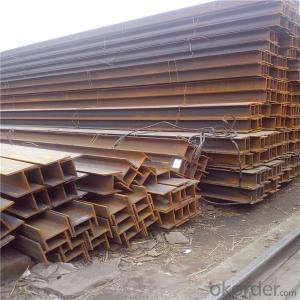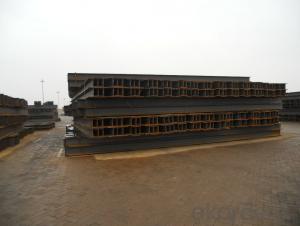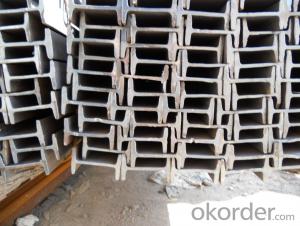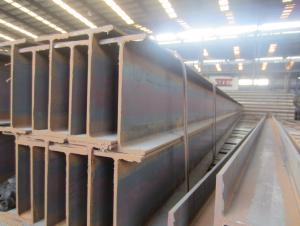China Hot Rolling Dip Galvanized H Beams Price per Kg
- Loading Port:
- Tianjin
- Payment Terms:
- TT OR LC
- Min Order Qty:
- 111 m.t
- Supply Capability:
- 10000 m.t/month
OKorder Service Pledge
OKorder Financial Service
You Might Also Like
Item specifice
Quick Details
OKorder is offering H BEAM at great prices with worldwide shipping. Our supplier is a world-class manufacturer of steel, with our products utilized the world over. OKorder annually supplies products to African, South American and Asian markets. We provide quotations within 24 hours of receiving an inquiry and guarantee competitive prices.
Place of Origin: | Tianjin, China (Mainland) | Grade: | Q235,Q345,Q215,Q195,20# | Technique: | Hot Rolled |
Thickness: | 3.2-6.5mm | Application: | Structural Beam | Length: | 6-12m, generally 12m, or according to your order |
Standard: | JIS, GB/T11263-2010/JISG3192-2008/EN10163 | Flange Width: | 58,59,123mm | Flange Thickness: | 4.5-6mm |
Web Width: | 118,119, 120mm | Web Thickness: | 4.5-6mm | Brand Name: | Yuxing |
Model Number: | HT 125x60/125x125 | product name: | Structural carbon steel h beam profile H iron beam (IPE,UPE,HEA,HEB) | Steel Grade(Equal International) 1: | SM490,SS400,S185,St33,S235JR,St37-2 |
Steel Grade(Equal International) 2: | ASTM A106/A106M A,S235JO, St37-3,E295, St50-2 | Steel Grade(Equal International) 3: | St50-2,S355JRH, ASTM A106/A106M C | Technical Method of Surface Treatment: | Hot-dipped galvanized |
Not of Specification: | The specification below in the table is more accurate | application: | structural beam | shape: | H beam |
We can provide qualify goods,competitive price and speedy delivery.
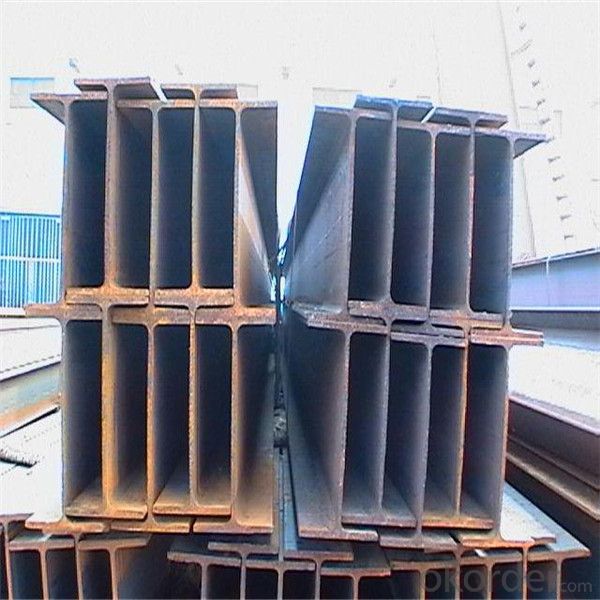
Products Description
H Type Steel Size and Theoretical Weight | |||||
Size | Theoretical Weight | Size | Theoretical Weight | Size | Theoretical Weight |
|
|
|
|
|
|
(mm) | (kg/m) | (mm) | (kg/m) | (mm) | (kg/m) |
100*50*5*7 | 9.3 | 250*125*6*9 | 29 | 446*199*8*12 | 65.1 |
100*100*6*8 | 16.9 | 250*250*9*14 | 71.8 | 450*200*9*14 | 74.9 |
125*60*6*8 | 13.1 | 294*200*8*12 | 55.8 | 482*300*11*15 | 110.8 |
125*125*6.5*9 | 23.6 | 298*149*5.5*8 | 32 | 488*300*11*18 | 124.9 |
148*100*6*9 | 31.1 | 340*250*9*14 | 36.7 | 496*199*9*14 | 77.9 |
150*75*5*7 | 14 | 300*150*6.5*9 | 93 | 500*200*10*16 | 88.1 |
150*150*7*10 | 20.7 | 300*300*10*15 | 78.1 | 582*300*12*17 | 132.8 |
175*90*5*8 | 18 | 346*174*6*9 | 41.2 | 588*300*12*20 | 147 |
175*175*7.5*11 | 40.4 | 350*175*7*11 | 49.4 | 596*199*10*15 | 92.4 |
194*150*6*9 | 29.9 | 350*350*12*19 | 134.9 | 600*200*11*17 | 103.4 |
198*99*4.5*7 | 17.8 | 390*300*10*16 | 104.6 | 700*300*13*24 | 181.8 |
200*100*5.5*8 | 20.9 | 396*199*7*11 | 56.1 | 800*300*14*26 | 206.8 |
200*200*8*12 | 49.9 | 400*200*8*13 | 65.4 | 900*300*16*28 | 240.1 |
244*175*7*11 | 43.6 | 400*400*13*21 | 171.7 |
|
|
248*124*5*8 | 25.1 | 440*300*11*18 | 120.8 |
|
|
Length=6------12meters | |||||
Packaging & Delivery
Packaging Details: | Packed with waterproof paper and steel banding. |
Delivery Detail: | 15-25 |
FAQ
1. How can I get some samples?
We are honored to offer you samples. New clients are expected to pay for the courier cost. The samples are free for you.
2 Do you have any certificates?
Our products passed inspection of SGS, FDA, and CE Quality is priority! Every worker keeps the QC from the very beginning to the very end, Quality control department especially responsible for quality checking in each process.
3 Can your factory print or emboss my logo on the goods?
Yes, we can print or emboss the logo on the goods or their packing box.
4 What information should I let you know if I want to get a quotation?
1) The specification of products (length x width x thickness);
2) The temper and alloy.
3) The final product you will use to be made
4 It will be better if you can show us the pictures or design sketch. Samples will be best for clarifying. If not, we will recommend relevant products with details for reference.We usually produce goods based on customers
Samples or based on customers’ picture, logo, sizes etc.
- Q:Can steel H-beams be used in marine or coastal environments?
- Yes, steel H-beams can be used in marine or coastal environments, but they require special coatings and maintenance to prevent corrosion. Steel H-beams are commonly used in the construction of marine structures, such as piers, docks, and offshore platforms, due to their strength and durability. However, exposure to saltwater and moisture can lead to accelerated corrosion of the steel beams. To mitigate this, the beams need to be properly coated with corrosion-resistant materials, such as epoxy or galvanized coatings. Additionally, regular inspection and maintenance are crucial to identify and address any signs of corrosion or damage. Failure to maintain the beams in a marine environment can significantly reduce their lifespan and compromise the structural integrity of the marine structure.
- Q:Is the beam made of I-beam or H?
- H section steel is a kind of economical section high efficiency profile with more optimized sectional area distribution and stronger weight ratio. It is named after the English letter "H". Because all the sections of H steel are arranged at right angles, H steel has been widely used in all directions for its advantages of high bending resistance, simple construction, cost saving and light weight.
- Q:What are the fire-resistant properties of steel H-beams?
- Steel H-beams have excellent fire-resistant properties due to their material composition and structural design. Firstly, steel is an inherently fire-resistant material. It has a high melting point, typically around 1370°C (2500°F), which means it can withstand high temperatures for extended periods without losing its structural integrity. This makes steel H-beams highly suitable for construction in fire-prone areas or buildings with specific fire safety requirements. Furthermore, the H-beam shape of the steel beam provides additional fire resistance. The H-shaped cross-section creates a larger surface area compared to other beam shapes, allowing heat to dissipate more efficiently. This helps to prevent the localized concentration of heat, which could weaken the beam and potentially lead to structural failure. In addition, steel H-beams do not contribute to fire spread or fuel the flames. Unlike combustible materials such as wood or some plastics, steel does not burn or release flammable gases when exposed to fire. This property ensures that the fire does not spread through the beams, helping to contain the fire within a limited area and prevent its rapid spread throughout the structure. Moreover, steel H-beams have a low thermal conductivity, meaning they do not readily transfer heat. This characteristic helps to slow down the transmission of heat from the fire to the surrounding areas, providing additional protection and preventing the fire from spreading to adjacent parts of the building. Overall, the fire-resistant properties of steel H-beams make them a reliable choice for structural applications in buildings where fire safety is a concern. Their ability to withstand high temperatures, dissipate heat efficiently, and prevent the spread of fire contributes to the overall fire resistance and safety of the structure.
- Q:How are steel H-beams protected against rust and corrosion?
- There are various methods available to protect steel H-beams from rust and corrosion. One commonly used technique involves applying a protective coating, such as paint or epoxy, to create a barrier between the steel and its surroundings. This coating prevents moisture and oxygen from reaching the metal surface and causing corrosion. To ensure maximum protection, multiple layers of the coating are typically applied. Another method is galvanization, which entails immersing the steel beams in molten zinc. This process creates a sacrificial barrier of zinc on the steel's surface. The zinc layer corrodes first, safeguarding the underlying steel from rusting. Galvanization is particularly effective in harsh environments and provides excellent corrosion protection. Corrosion inhibitors can also be used to treat steel H-beams. These chemicals can be applied as a coating or through a dipping process. They create a protective film on the metal surface, inhibiting the corrosion process. To maintain long-term protection against rust and corrosion, it is crucial to conduct regular maintenance and inspections. Any damages or breaches in the protective coating should be promptly addressed, and the beams should be regularly cleaned to remove accumulated dirt, debris, and corrosive substances. In conclusion, a combination of protective coatings, galvanization, and corrosion inhibitors, along with proper maintenance, can effectively safeguard steel H-beams from rust and corrosion. This approach extends their lifespan and ensures structural integrity.
- Q:Can steel H-beams be used in the construction of military or defense buildings?
- Indeed, military or defense buildings can utilize steel H-beams in their construction. Due to their robustness, durability, and adaptability, steel H-beams are frequently employed in construction endeavors. Their purpose is to withstand substantial loads and furnish structural stability, thereby rendering them fitting for military and defense buildings necessitating sturdy and secure frameworks. Furthermore, the fabrication and installation of steel H-beams are effortless, enabling streamlined construction procedures. Ultimately, steel H-beams present themselves as a dependable and pragmatic option for erecting military or defense buildings.
- Q:What are the different design codes and standards applicable to steel H-beams?
- There are several design codes and standards applicable to steel H-beams, which ensure their structural integrity and safe usage in various applications. Some of the prominent design codes and standards include: 1. American Institute of Steel Construction (AISC): AISC provides design guidelines and specifications for steel structures, including H-beams. The AISC Manual of Steel Construction is widely used in the United States and provides comprehensive information on the design, fabrication, and erection of steel structures. 2. European Norms (EN): The European Norms, specifically EN 1993-1-1 (Eurocode 3), provide design rules for steel structures in Europe. These norms include provisions for the design of H-beams and their connections, taking into account factors such as material properties, loadings, and stability requirements. 3. British Standards (BS): British Standards, such as BS 5950-1 and BS EN 1993-1-1, provide design recommendations for steel structures in the United Kingdom. These standards cover the design of H-beams, including factors like member capacities, buckling resistance, and connection design. 4. Canadian Standards Association (CSA): CSA S16, the Canadian standard for the design of steel structures, includes provisions for the design and analysis of H-beams. This standard covers topics like member design, stability considerations, and seismic design requirements. 5. Australian Standards (AS): The Australian Standards, particularly AS 4100, provide guidelines for the design and construction of steel structures in Australia. These standards cover the design of H-beams, including aspects like loadings, material properties, and construction details. 6. International Organization for Standardization (ISO): ISO 14346 is an international standard that specifies the requirements for hot-rolled H-beams with narrow flanges and wide flanges. It provides dimensional and structural specifications for H-beams manufactured globally. These design codes and standards serve as crucial references for engineers and designers involved in the design and construction of steel H-beams. By following these guidelines, they can ensure the structural safety, integrity, and compliance of H-beams with industry-accepted practices and regulations.
- Q:How do steel H-beams contribute to daylighting in buildings?
- Steel H-beams play a crucial role in daylighting in buildings by providing structural support while allowing for larger and more expansive windows. Daylighting refers to the use of natural light to illuminate the interior spaces of a building, reducing the need for artificial lighting and creating a more sustainable and pleasant environment. With their strong load-bearing capabilities, steel H-beams can span long distances and support heavy loads, making it possible to have larger window openings. These windows can be strategically placed on exterior walls or even in the roof, allowing natural light to flood into the building's interior. The use of steel H-beams in construction also enables architects to design buildings with open floor plans and soaring ceilings. This architectural freedom allows for the creation of atriums, skylights, and other light wells that further enhance daylight penetration. Moreover, steel H-beams are incredibly durable and resistant to deformation, ensuring that the structural integrity of the building is maintained while maximizing the amount of natural light that enters the space. This is especially important in areas prone to earthquakes or high winds. In addition to their structural benefits, steel H-beams are versatile in terms of design and aesthetics. They can be incorporated into various architectural styles, allowing for innovative and visually appealing building designs that prioritize daylighting. Overall, steel H-beams contribute significantly to daylighting in buildings by providing the necessary strength and support for larger windows, allowing for creative architectural designs, and ensuring the durability of the structure. By harnessing natural light, buildings can reduce energy consumption, improve occupants' well-being, and create more sustainable and inviting spaces.
- Q:How do steel H-beams contribute to energy-efficient buildings?
- Steel H-beams play a crucial role in constructing energy-efficient buildings due to their unique structural properties and sustainability benefits. Firstly, H-beams are known for their exceptional strength-to-weight ratio, allowing for the creation of large, open spaces without the need for excessive structural support. This feature enables architects to design buildings with more natural light and better airflow, reducing the need for artificial lighting and ventilation systems and ultimately decreasing energy consumption. Moreover, steel H-beams can be fabricated to precise dimensions, ensuring accurate assembly and minimizing waste during construction. This not only saves resources but also reduces the energy required for manufacturing and transportation of materials. Additionally, steel is a highly recyclable material, making H-beams a sustainable choice for construction. The recycling process requires significantly less energy compared to producing new steel, reducing greenhouse gas emissions and conserving natural resources. Beyond their structural benefits, steel H-beams also contribute to energy efficiency through their thermal properties. Steel is a good conductor of heat, which allows for efficient transfer and distribution of thermal energy within a building. This feature enables better insulation and temperature control, reducing the reliance on heating and cooling systems and consequently reducing energy consumption. Another advantage of steel H-beams is their durability and resistance to environmental factors such as fire, earthquakes, and pests. This durability ensures the longevity of energy-efficient buildings, reducing the need for frequent repairs and replacements, which in turn saves energy and resources. In conclusion, steel H-beams contribute to energy-efficient buildings by providing a strong, lightweight, and sustainable structural solution. Their ability to create open and spacious designs, accurate fabrication, thermal efficiency, and durability all contribute to reducing energy consumption and promoting sustainability in construction.
- Q:How do steel H-beams perform in areas with high snow load?
- Steel H-beams are known for their exceptional strength and durability, making them well-suited for areas with high snow loads. The H-shaped profile of these beams provides increased structural stability, allowing them to effectively withstand the weight and pressure exerted by heavy snow accumulation. One of the key advantages of steel H-beams in snowy regions is their high load-bearing capacity. The H-shape design distributes weight evenly across the beam, reducing the risk of bending or deformation under intense snow loads. This ensures that the structural integrity of buildings or structures remains intact, mitigating the potential risks associated with heavy snowfall. Moreover, steel H-beams have excellent resistance to bending, twisting, and shearing forces. These properties make them highly reliable and capable of withstanding the dynamic loads imposed by snow loads, such as the weight of snow sliding off a roof or the impact of strong winds combined with snowfall. Additionally, steel H-beams are known for their resistance to corrosion, which is particularly important in areas with high snow loads. Snow can contain moisture that may penetrate the structural components of a building, potentially leading to rusting and weakening of the material. However, steel H-beams are typically coated with protective layers or galvanized to prevent corrosion, ensuring their long-term performance and structural integrity in harsh snowy environments. In summary, steel H-beams are an excellent choice for areas with high snow loads due to their superior strength, load-bearing capacity, resistance to deformation, and corrosion resistance. These beams provide a secure and durable structural support system, ensuring the safety and stability of buildings and structures under heavy snowfall conditions.
- Q:Can steel H-beams be used for curtain walls?
- Yes, steel H-beams can be used for curtain walls. Steel H-beams are commonly used in construction for their strength and durability. They provide excellent load-bearing capabilities, making them suitable for supporting curtain wall systems. Curtain walls are non-structural, lightweight, and typically made of glass or other materials. The H-beams can be used as the primary structural support for the curtain wall, allowing for large, open areas of glazing while ensuring stability and safety. Additionally, steel H-beams can be customized to meet the specific design requirements of the curtain wall system, making them a versatile choice for this application.
1. Manufacturer Overview |
|
|---|---|
| Location | |
| Year Established | |
| Annual Output Value | |
| Main Markets | |
| Company Certifications | |
2. Manufacturer Certificates |
|
|---|---|
| a) Certification Name | |
| Range | |
| Reference | |
| Validity Period | |
3. Manufacturer Capability |
|
|---|---|
| a)Trade Capacity | |
| Nearest Port | |
| Export Percentage | |
| No.of Employees in Trade Department | |
| Language Spoken: | |
| b)Factory Information | |
| Factory Size: | |
| No. of Production Lines | |
| Contract Manufacturing | |
| Product Price Range | |
Send your message to us
China Hot Rolling Dip Galvanized H Beams Price per Kg
- Loading Port:
- Tianjin
- Payment Terms:
- TT OR LC
- Min Order Qty:
- 111 m.t
- Supply Capability:
- 10000 m.t/month
OKorder Service Pledge
OKorder Financial Service
Similar products
New products
Hot products
Hot Searches
Related keywords
